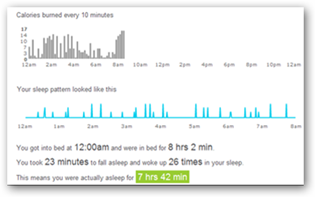Nobody can argue with the fact that employers who provide gyms, healthy eating advice, nurses or doctors on premise are not a good thing, it’s a  huge convenience and helps. Of course larger companies have the abilities more so than smaller employers to provide this type of service. Being an employee, I would go visit to get a flu shot or get additional information if I needed it.
huge convenience and helps. Of course larger companies have the abilities more so than smaller employers to provide this type of service. Being an employee, I would go visit to get a flu shot or get additional information if I needed it.
As noted below though, sometimes the advice and help can feel intrusive when perhaps it gets down to what you eat for lunch every day. There are financial incentives too for those who participate with health risk surveys and more. As money continues to be the issue for health insurance and more cost being put upon the consumer, there are more people than just your mom and dad wanting to know what you doing for your lifestyle.
Wellness programs are still somewhat in their infancy and evolving too, so we see more new incentives showing up as unhealthy employees use more resources than those that are healthy reports state. As a society we have had some type of wellness program available for years, we help those with drug addictions, alcohol problems, you name it, public and private programs have been in place for years for those who want to avail themselves of the help that is offered and I see the employer involvement as an extension of such services to a degree too, which can be a good thing. 
With Wellness programs too we do need balance to present and run such programs in a positive direction. The results of any program are always better with a positive choice to participate rather than one where an individual feels forced or coerced. As mentioned above, Wellness programs are still somewhat new in the employer arena and are evolving and the hope is to keep such programs to be well meaning as well, but somewhere in a few blogs I have read some interesting comments about the programs where it is maybe not an elective choice but rather intrusively encouraged, so now we have a need to perhaps create some balance here.
There are many ways programs can expand themselves and one is through the use of medical devices, “smart” devices that now offer health data to analyze to measure outcomes of such programs and this is somewhat of a fine line to cross as to when does it get close to crossing the line and become more of a compliancy issue rather than incentive? This is where I see the PHR, or personal health record coming in to play, as it gives an individual the opportunity and tools to use the information themselves to improve their lifestyles, and if used in a positive direction we might see some real progress in this area.
Devices go much further though than just measuring your weight and heart rate too, we have defibrillators that send information via Bluetooth to data collecting areas, so now we have treatment and wellness occurring together as a dual billing. Overall though, if one were using a device that is implanted and chooses to use a pedometer, or glucose machine that reports data, they all need to somehow work together and come under one roof. We are all familiar with the drug commercials we see every day that say “ask your doctor if this ok for you” all over television, and the same should hold true for some wellness methodologies. What regiment of exercise might be the best for you.
The key is to keep your doctor and you in the loop so intelligent decisions can be made, and not a one cure for all wellness solution is used as what might be a good plan for one, may not work for the next. There are common grounds for healthy living that all promote obviously, but just as medicine is getting very personalized, so is wellness. The PHR is the common ground where everything can be evaluated and lays the footwork for such a process to take place, again with your doctor involved.
High-tech gadgets hit doctor-patient relationships and more..
I have written quite a bit about this topic and have included some links below for more information, but again as wellness continues to evolve, so does the technology used to facilitate such programs and it is something we should all be aware of, as without balance it could fall short of everyone’s expectations and defeat the purpose if it is done in manners that are considered intrusive and demanded. You also need to know where your data is going and who gets it with devices, and we don’t want to give up that choice and not know who is collecting the data, who they give it to for analysis and become a slave to a device that tends to “prove” what we do rather than to create an incentive. 
The solution lies within a PHR where you the individual can make those choices rather than signing a waiver and having them made for you, which is what will occur if participation levels do not tend to increase, so go get your PHR and take control. There are some very interesting and sophisticated products on the market today, even a Bluetooth inhaler that reports back to when use it, pedometers that track how much walking you do, and even other devices that track how much you walked and how much sleep you get every day, so be aware that these are out there and they will begin appearing in some form or another. There is also a new device for inhaling insulin going to the FDA soon for approval, so will there be a reporting data attached to a device as such if approved? These devices will vibrate, buzz and alert you too if it determines are you not moving enough too.
And then there’s this danger of non participation too…..
Personal Health Records (PHR), I don’t do technology said the CEO, “it’s for those guys over there”
Is this a do as I say proposition and not a do as I do?
Over in the UK a test program was run giving children heart monitors to “help control unruly children” by teaching them to monitor their heart rates. As I mentioned if I were an unruly kids I would probably destroy it anyway (grin).
Here’s one other interesting device to look at:
“No, the Fitbit can record detailed daily data (minute by minute calorie burn and sleep data) for 7 days and summarized daily data (daily steps, calories and distance) for 30 days. Once the Fitbit is within range, it will automatically upload any stored data that it has recorded.”
“The Fitbit Tracker contains a motion sensor like the ones found in the Nintendo Wii. The Tracker senses your motion in three dimensions and converts this into useful information about your daily activities. The Tracker measures the intensity and duration of your physical activities, calories burned, steps taken, distance traveled, how long it took you to fall asleep, the number of times you woke up throughout the night and how long you were actually asleep vs. just lying in bed.”
It will tell you what you did in your sleep and creates this report that transmits as soon as you are in range and they plan to sell for $100.00, so the technology is not expensive either.
Insurers are also very interested in devices too, for a quick example Aetna announced a pilot program with a device to contain a lottery for those to make a few dollars if they took their pill.
Aetna "Take your Pill" Lottery...
To sum this all up, wellness, a PHR and your doctor all together are the key to success here as a team effort and the best way to create your team is with a PHR, not only for your own use, but to also protect your privacy rights and choose who gets to be the recipient of your personal data. BD
Once upon a time, corporations offered generous health benefits as a way to woo employees into their ranks. Now, most companies have turned from amorous suitors into stern parents — shifting more costs, and more responsibilities, to their employees.
According to a January survey by the benefits consulting firm Hewitt Associates, nearly two-thirds of large employers planned to transfer more costs to employees. At the same time, one-third planned to put greater emphasis on wellness plans — programs that encourage employees to adopt healthier lifestyles. (So long, Big Macs).
Congress is climbing onto the wellness bandwagon, too. Senator Tom Harkin, the Iowa Democrat who is a leader of the Congressional health reform movement, recently proposed giving tax incentives to companies that offer comprehensive wellness programs to their employees.
But some aspects of wellness plans may feel more meddlesome. About 80 percent of big employers offer health risk surveys, which are aimed at identifying health problems or potential health problems. And 60 percent of employers give financial incentives to employees who fill them out, according to a joint survey by the benefits consulting firm Watson Wyatt and the National Business Group on Health, an association of more than 300 large employers.
“It’s one thing for an employer to offer insurance that protects you from illness,” says Ronald C. Kessler, a professor of health care policy at Harvard Medical School. “It’s another when they start suggesting that you shouldn’t eat a P.B.&J. sandwich for lunch. That can feel intrusive.”
Patient Money - Getting Healthy, With a Little Help From the Boss - NYTimes.com
Related Reading:



0 comments :
Post a Comment